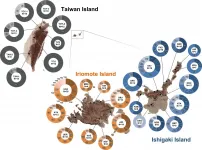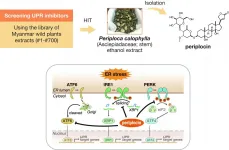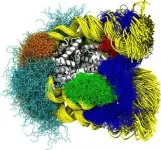(Press-News.org) The Amami, Okinawa region of Japan may be designated a World Heritage Site in July of 2021 based on the recent recommendation from the IUCN. The Iriomote wild cat is a symbolic species of the region, having evolved independently on the island. The area is home to many other highly endemic and unique evolutionary species. A research group comprised mostly of former students of Professor Koji Tojo's Faculty of Science lab of Shinshu University focused on the study of dragonflies, continuing from their previous study of their comparative embryogenesis. About 5,000 species of insects belonging to 26 families of the order Dragonfly are known in the world, but those with some gill-shaped protrusions on the abdomen of the larva are extremely rare. Professor Tojo's lab had been studying the Euphaea yayeyamana and the Bayadera brevicauda of the same Euphaeidae dragonfly family in Japan.
Professor Tojo considers that the abdominal gills of these dragonflies are important traits in the origin of insect wings and have studied embryology and developmental genetics targeting this area. In the process of such study, they noticed an interesting genetic feature that is the subject of this paper. Population genetics theory implies that smaller populations that are fragmented contain less genetic diversity than larger populations. They will have a higher rate of genetic fixation due to inbreeding and random genetic drift. However, the result of their genetic analysis of the mitochondrial DNA COI region revealed that E. yayeyamana (Ishigaki/Iriomote) which inhabits smaller islands, has a higher genetic diversity than E. formosa (Taiwan) which inhabits larger island.
Generally, in a small island environment, the population size remains small, so genetic diversity tends to be kept low. Ishigaki Island and Iriomote Island, which were the targets of this study, are only 1/125 and 1/155 in area, respectively, compared to Taiwan. The scale of the mountainous areas on the island is also very different, with the highest altitudes of Ishigaki Island and Iriomote Island being 469 m and 526 m, respectively, while the highest peak in Taiwan is 3,952 m. As for the habitat of Euphaea dragonflies inhabiting mountainous areas, Taiwan has more diverse environments than Ishigaki and Iriomote.
The speciation of E. yayeyamana in Yaeyama (Ishigaki / Iriomote) and E. formosa in Taiwan is estimated to be about 1.4 million years ago. In addition, this study clarified that the genetic diversity of the E. yayeyamana in Ishigaki and Iriomote is much higher than the genetic diversity of the E. formosa in Taiwan. As a result of wide-ranging and comprehensive sampling and gene analysis on both Ishigaki and Iriomote islands, dispersion was found to have occurred within Ishigaki Island and Iriomote Island, and gene flow within each island is actively occurring. On the other hand, gene flow between islands was not observed, and a large genetic differentiation was observed. In addition, it became clear that in the past, there were at least three dispersals from Ishigaki Island to Iriomote Island. The dispersion between Ishigaki Island and Iriomote Island is probably due to the westerly wind (probably Taiwan ? Iriomote ? Ishigaki). No such sign is observed for dispersion in the opposite direction. In other words, it was found that the genomes of dragonflies unique to Taiwan and the Yaeyama region are engraved with genetic information that strongly reflects the effects of geological history and meteorology.
The results of this study were very surprising. The investigation into the cause of such a genetic structure remains a mystery, but Professor Tojo believes that "in Taiwan, a phenomenon such as the "bottleneck effect" that once caused a significant reduction in population size occurred. On the other hand, on Ishigaki and Iriomote Islands, habitats such as those inhabited by E. yayeyamana have been relatively stable over a wide area of the island. In the northeastern peninsula of Ishigaki Island, the forest environment tends to be small and divided. As a result, genetic diversity is also kept low in this area. Through this research, I became keenly aware of the importance of actually analyzing data without being overwhelmed by prejudice."
Not only is the evolutionary history but the morphological traits are unique to this area, and the group is planning to continue to analyze the genetic structure using various molecular markers in addition to pursuing the relationship between morphogenesis and the genetic basis. While adding the analysis of nuclear DNA, the group have analyzed another region of mitochondrial DNA and would like to re-evaluate the gene flow scale using more sensitive gene markers.
INFORMATION:
Acknowledgements: We thank Drs H. Kohno, A. Mizutani (Okinawa Regional Research Center, Tokai University), Mr. H. Uehara (Iriomote Station, Tropical Biosphere Research Center, University of the Ryukyus), Dr. M. Nishikawa (Itano Town, Tokushima), Dr. K. Ishida (Gifu City), Dr. A.T.-S. Lin (Department of Earth Sciences, National Central University, Taiwan), Professor H. Chi (Department of Entomology, National Chug Hsing University, Taiwan), Dr. K. Iizumi (Tropical Agricultural Research Front, Japan International Research Center for Agricultural Sciences), Ms. Y. Watanabe (Nishinomiya City), Mr. H. Yokota (Osaka City), Prof. K. Hoyanagi, Dr. K. Yamada, Mr. T. Kano (Faculty of Science, Shinshu University) and many students of the Department of Entomology, National Chug Hsing University, for their help in collecting specimens. We also thank Dr. R.B. Kuranishi and two reviewers for helpful comments that have improved the manuscript.
Photo Credits:
Emi KANKE (graduated Fac. of Science, Shinshu University, Tojo Lab), Kohei SUZUKI (MS from Shinshu University, Tojo Lab), Kazuki SEKINÉ (Assistant Professor, Dept. of Environment, Rissho University, MS and PhD from Shinshu University, Tojo Lab), Tomoya SUZUKI (Kyoto University PD, MS and PhD from Shinshu University, Tojo Lab), Kokichi HATTA (Professor Emeritus Nagoya Womens University, Man-Miao YANG (Professor, Chukyo University Taiwan), Koji TOJO (Shinshu University Faculty of Science, Institute for Mountain Science)
Paper:
Emi KANKE, Kohei SUZUKI, Kazuki SEKINÉ, Tomoya SUZUKI, Kokichi HATTA, Man-Miao YANG and Koji TOJO.
Unique population genetic structure of two closely related euphaeid damselflies in the Yaeyama and Taiwan Islands (Odonata: Euphaeidae).
Biological Journal of the Linnean Society, 2021
A long-standing basic question in biology relates to how life satisfies the fundamental constraints put on it by physics and chemistry. Darwin's warm pond hypothesis for the origin of primordial cells is a familiar one. Advances have been made in mapping out the organic molecules that likely existed on the early Earth, and recently candidate prototypic pathways in early cells have been formulated. But how did these candidates' early biochemistry actually function as a system, on which subsequent cellular life is based?
A team of bioengineers at the Novo Nordisk Foundation Center for Biosustainability, DTU, has now defined ten overarching classes of constraints on early metabolic ...
A minimally-invasive procedure that targets the nerves near the kidney has been found to significantly reduce blood pressure in hypertension patients, according to the results of a global multicentre clinical trial led in the UK by researchers at Queen Mary University of London and Barts Health NHS Trust.
The study, published in The Lancet and presented at the American College of Cardiology meeting, suggests that the procedure could offer hope to patients with high blood pressure who do not respond to recommended treatments (resistant hypertension), and are at greatly increased risk of cardiovascular diseases, including stroke and heart attack.
The international clinical trial tested a one-hour procedure called 'renal denervation', which uses ultrasound energy to ...
The fluorescence dyes were dominant species of the near-infrared (NIR) dyes, but the energy gap of the NIR dyes between S1 state and S0 state is generally small to induce the ultrafast internal conversion dynamics to quench the NIR emission of the fluorescence dyes. Therefore, the quantum yield of the fluorescence NIR dyes is usually low. On the other hand, the organic dyes with room-temperature phosphorescence (RTP) in the NIR region could prevent the ultrafast internal conversion dynamics quenching because of the T1 state and S0 state the organic molecules are spin forbidden.
Recently, scientists in China reported a new assumption to construct ...
The Spanish Foundation for Science and Technology (FECYT) has presented this week at the headquarters of the National Science and Technology Museum in Madrid the main results of the 10th Social Perception of Science Survey carried out in 2020.
The presentation was attended by Pedro Duque, Minister of Science and Innovation, Josep Lobera, Professor of Sociology at the Autonomous University of Madrid (UAM) and scientific co-director of the Survey and the subsequent study, and Rosa Capeáns, Director of the Scientific Culture and Innovation Department of FECYT. Pampa García, Editor-in-Chief of the SINC Agency, moderated a debate in which the results were presented in six blocks: Interest in ...
In the present study, Dr. Hidetoshi Hayashi (Professor, Nagoya City University) and collaborators screened small-molecule compounds that suppress UPR, using Myanmar wild plant extracts library. The screening system to track X-box binding protein 1 (XBP1) splicing activity revealed that the ethanol extract of the Periploca calophylla stem inhibited the inositol-requiring enzyme 1 (IRE1)-XBP1 pathway. They isolated and identified periplocin as a potent inhibitor of the IRE1-XBP1 axis. Periplocin also suppressed other UPR axes, protein kinase R-like endoplasmic reticulum kinase (PERK), and activating transcription ...
Researchers from the Hubrecht Institute in Utrecht (The Netherlands) and the Max Planck Institute for Molecular Biomedicine in Münster (Germany) used computer simulations to reveal in atomic detail how a short piece of DNA opens while it is tightly wrapped around the proteins that package our genome. These simulations provide unprecedented insights into the mechanisms that regulate gene expression. The results were published in PLOS Computational Biology on the 3rd of June, 2021.
Every cell in the body contains two meters of DNA. In order to fit all the DNA ...
Health has always been affected by climate and weather, but is increasingly clear that the change in climate is a significant threat to human health. The World Health Organization (WHO) estimates that 24% of global deaths are linked to environmental factors [1]. Climate change and pollution can lead to undernutrition, mental disorders, and noncommunicable diseases including chronic kidney disease and acute kidney injury [2].
The burden of addressing the death and disability associated with climate change falls to nephrologists and other healthcare professionals. At the same time, the healthcare sector makes a major ...
SGLT2 inhibitors (gliflozins) were developed as oral antidiabetics. They enhance urinary glucose excretion by inhibiting SGLT-2 (sodium-dependent glucose co-transporter-2) in the renal tubuli. The discovery of kidney benefits beyond the lowering of blood sugar has been made by Professor Christoph Wanner from Germany: The EMPA-REG OUTCOME study [2] initially showed that the rate of cardiovascular events in type 2 diabetic pa-tients is significantly reduced if the SGLT2 inhibitor empagliflozin is administered. Kidney function in diabetics who already had diabetic nephropathy was also found to benefit sig-nificantly from the treatment ...
HOUSTON - (June 7, 2021) - If identical versions of 20 people lived out their lives in dozens of different worlds, would the same people be popular in each world?
If you substitute "fruit flies" for "people" in that question, you have a fair description of a Rice University study showing that the evolution of social structures and the positions of individuals within those structures are based partly on genetics.
Cloned fruit flies played a starring role in the study that researchers jokingly likened to "The Truman Show," with video cameras observing how the flies behaved in a controlled environment.
In the study published online this week in Nature Communications, Rice bioscientists Eric Wice and Julia Saltz ...
The kidneys are a target organ of COVID-19 and are affected very early in the course. However, this is precisely where there is strong prognostic potential: As early as last spring, COVID-19-associated nephritis was identified as an early warning signal for severe courses of the infectious disease and studies to that effect were published [1]. In that regard, the research group led by Professor Oliver Gross, Department of Nephrology and Rheumatology at Göttingen University Medical Center (UMG), screened 223 patients in a study and included 145 of them as a predictive cohort. Study endpoints were ICU admission or mortality. As a result, early urinary changes ...





